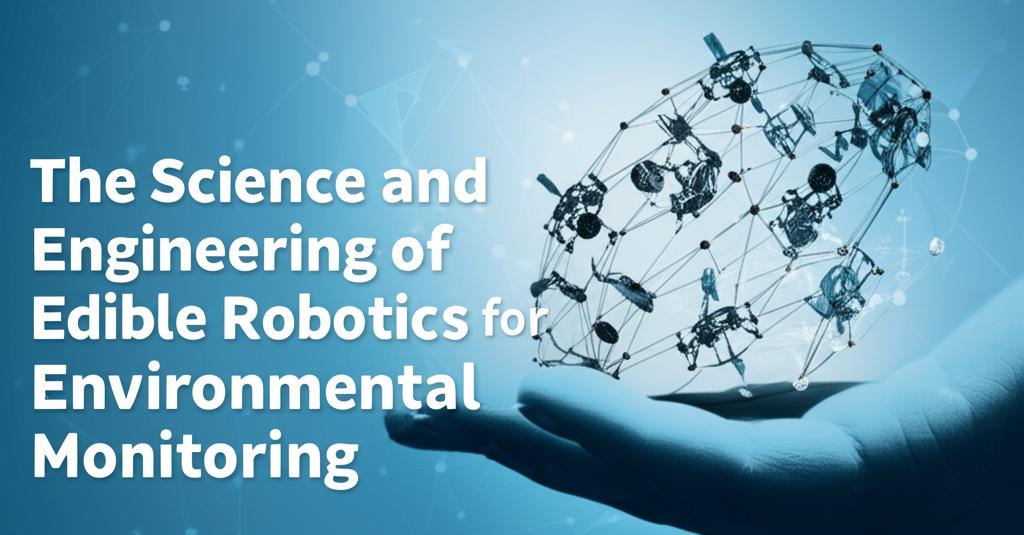The pursuit of edible robotics for environmental monitoring represents a significant leap towards sustainable and eco-friendly technological solutions. This interdisciplinary field merges materials science, electrical engineering, food science, and robotics to create devices that can perform monitoring tasks and then safely biodegrade or even be consumed, minimizing electronic waste and environmental impact.
Core Concepts and Motivations:The primary driver behind edible robotics in environmental monitoring is the reduction of electronic waste. Traditional monitoring devices are often made from non-biodegradable plastics and electronics that contribute to pollution when their lifespan ends. Edible robots, constructed from food-grade and biodegradable materials, offer a solution by naturally decomposing or being consumed by wildlife after their mission is complete. This approach is particularly beneficial for monitoring in sensitive ecosystems where retrieving devices is difficult or disruptive.
Key Scientific and Engineering Aspects:- Biodegradable and Edible Materials:
Researchers are exploring a wide array of natural and food-based materials to construct the bodies, actuators, sensors, and even power sources of these robots.
Structural Components: Materials like gelatin, rice cakes, potato starch, and cellulose derivatives (like nanofibrillated cellulose) are being used to create the main body of the robots. For instance, drones with rice cake wings and gelatin glue have been developed. Researchers at the École Polytechnique Fédérale de Lausanne (EPFL) have even created aquatic robots from a modified fish food compound, making them tough, resilient, and ultimately consumable by marine life.
Actuators: Gelatin-based polymers are being investigated for creating artificial muscles that can enable movement. The challenge lies in achieving sufficient elasticity and durability for pneumatic or electrical actuation while remaining edible and palatable.
Sensors: Edible sensors are being developed using materials like conductive inks made from activated carbon and gummy bears, or by leveraging the natural semiconducting properties of food dyes, pigments (e.g., carotenoids, xylindein from fungi), and gold leaf. These sensors can detect parameters such as pH, temperature, light, bending, and the presence of pollutants or microorganisms.
Power Sources: A significant breakthrough is the development of rechargeable edible batteries. Researchers at the Italian Institute of Technology (IIT) created a battery using riboflavin (vitamin B2) for the anode and quercetin (found in almonds and capers) for the cathode, with activated carbon to facilitate electron transfer and nori seaweed as a separator, all encapsulated in beeswax. Common food ingredients and supplements are also being explored for temporary power.
- Propulsion and Locomotion:
Innovative methods are being devised for robot movement. For aquatic robots, EPFL scientists have utilized the Marangoni effect, where a change in surface tension propels the robot. This is achieved by a chemical reaction (e.g., citric acid and sodium bicarbonate generating carbon dioxide) that expels a biodegradable fuel (like propylene glycol), reducing surface tension and moving the robot. This mimics the locomotion of some aquatic insects.
- Biodegradability and Eco-Impact:
A core principle is that materials digestible by humans or animals are also biodegradable in nature. This minimizes the environmental footprint. Edible robots are designed to leave no harmful residues. For example, an edible drone left in the environment would biodegrade, unlike its plastic counterparts.
Applications in Environmental Monitoring:Edible robots hold promise for a variety of environmental monitoring applications:
- Water Quality Monitoring: Deploying edible aquatic robots to collect data on water pH, temperature, pollution levels, and microorganism presence in lakes, coastal regions, and other water bodies.
- Wildlife Monitoring and Support: Using edible robots to monitor wildlife in remote areas, potentially even delivering nutrients or vaccines to animals. Their edibility ensures they don't harm animals if ingested.
- Difficult-to-Access Area Surveillance: Biodegradable drones made from materials like potato starch can carry sensors to collect environmental data in areas that are challenging for humans or conventional robots to reach.
- Agricultural Monitoring: Edible sensors could monitor crop growth and environmental conditions in fields.
The field is rapidly advancing, with several key research initiatives:
- RoboFood Project: Coordinated by Dario Floreano (EPFL) and involving multiple institutions, this EU-funded project explores which edible ingredients can create robot components and aims to assemble them into fully edible robots for applications like healthcare, nutrition delivery, and environmental monitoring.
- ELFO (Electronic Food) Project: Led by IIT, this project focuses on creating circuits and sensors that can decompose within the body (for medical applications) or in the environment. They aim to provide foundational technology for edible electronic systems, with a project completion target of 2025.
Despite promising advancements, several challenges remain:
- Component Integration: Combining electrical components (batteries, sensors) with those that use fluids and pressure for movement (actuators) into a fully functional and edible system is a major hurdle.
- Performance and Reliability: Edible actuators and energy sources currently have lower power, endurance, and reliability compared to their non-edible counterparts.
- Miniaturization: Making these robots small enough for certain applications (like ingestion for internal monitoring or unobtrusive environmental deployment) is crucial.
- Shelf Life and Robustness: Edible components need to withstand environmental conditions (e.g., temperature, moisture) during their operational lifespan and have a reasonable shelf life.
- Safety and Palatability: While many materials are "generally regarded as safe" (GRAS), the interactions of multiple components and their overall safety and appeal for consumption (by animals in environmental contexts) need further study. Clinical validation for internal human use is a significant step.
- Computation: Developing edible computational devices using biomaterials that match the performance and stability of traditional semiconductors is an ongoing challenge.
Future developments will likely focus on enhancing the performance of edible components, achieving seamless integration, and scaling up production. Collaborative efforts between researchers in robotics, materials science, food technology, and environmental science are essential. As the technology matures, edible robots could revolutionize environmental monitoring by providing a truly sustainable and harmonious way to gather vital data about our planet, leaving no trace but knowledge. Projects like RoboFood and ELFO are paving the way for this "digital ecology," where technology and nature can coexist more synergistically.

